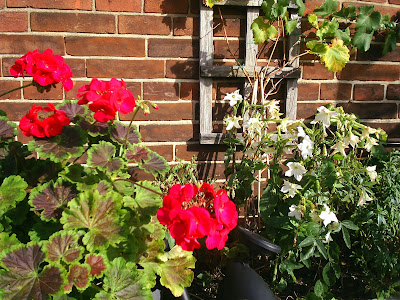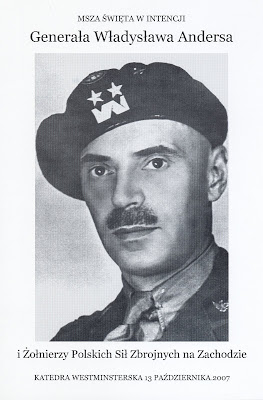
Sunday, 28 October 2007
A Mournful Anniversary

Posted by
Mark Langham
at
03:39
1 comments
![]()
Saturday, 27 October 2007
O Light Celestial
 The pure light - which in Byzantine churches represents the illumination of the Holy Spirit - floods into the Cathedral. For this reason, there is no stained glass in Byzantine ecclesiastic architecture.
The pure light - which in Byzantine churches represents the illumination of the Holy Spirit - floods into the Cathedral. For this reason, there is no stained glass in Byzantine ecclesiastic architecture.
Posted by
Mark Langham
at
05:00
0
comments
![]()
Friday, 26 October 2007
The Cathedral That Never Was
 With recent postings on the foundations of the Cathedral in 1895, it might be worth looking at an earlier project. Cardinal Vaughan himself considered other designs before settling upon the surprising Byzantine proposal of John Francis Bentley. But as early as 1867, Cardinal Manning had approached the architect Henry Clutton to come up with designs - this was even before he purchased the Victoria site in 1884. The illustrations here were produced by Clutton in 1873.
With recent postings on the foundations of the Cathedral in 1895, it might be worth looking at an earlier project. Cardinal Vaughan himself considered other designs before settling upon the surprising Byzantine proposal of John Francis Bentley. But as early as 1867, Cardinal Manning had approached the architect Henry Clutton to come up with designs - this was even before he purchased the Victoria site in 1884. The illustrations here were produced by Clutton in 1873. Clutton's design was for a French style gothic Cathedral - an idiom never beloved of Cardinal Manning who preferred Italianate architecture. In the end, the Cardinal had other priorities, most notably the building of catholic schools and the relief of the poor. It was Clutton's pupil, Bentley, who enventually was to build the Roman Catholic Cathedral.
Clutton's design was for a French style gothic Cathedral - an idiom never beloved of Cardinal Manning who preferred Italianate architecture. In the end, the Cardinal had other priorities, most notably the building of catholic schools and the relief of the poor. It was Clutton's pupil, Bentley, who enventually was to build the Roman Catholic Cathedral.
Posted by
Mark Langham
at
02:47
5
comments
![]()
Thursday, 25 October 2007
Laying the Foundations II
 As chance would have it following the posting of two days ago, I came upon these photographs from the 1896 Cathedral record. The first, above, is dated October 10 1895.
As chance would have it following the posting of two days ago, I came upon these photographs from the 1896 Cathedral record. The first, above, is dated October 10 1895.
 The second and third are dated May 1 1896, and show the considerable progress that had been made. Above, St Anne's anglican church, destroyed by bombing in the the Second World War, may be seen. It is astonishing to think that the Cathedral was completed by 1904.
The second and third are dated May 1 1896, and show the considerable progress that had been made. Above, St Anne's anglican church, destroyed by bombing in the the Second World War, may be seen. It is astonishing to think that the Cathedral was completed by 1904.
Posted by
Mark Langham
at
06:22
1 comments
![]()
Canon Law Society Mass

Posted by
Mark Langham
at
06:16
0
comments
![]()
Wednesday, 24 October 2007
Tuesday, 23 October 2007
Laying the Foundations I
 The foundations of the Cathedral in 1895. To the right, the familiar mansion blocks of Ashley Gardens are already in place. Ahead, the buildings that flank the south side of Victoria Street, and that were to face the west door of the Cathedral. One of them was to house Burns and Oates, the Catholic publishing house. They were demolished in the 1970s, when the Cathedral piazza was built.
The foundations of the Cathedral in 1895. To the right, the familiar mansion blocks of Ashley Gardens are already in place. Ahead, the buildings that flank the south side of Victoria Street, and that were to face the west door of the Cathedral. One of them was to house Burns and Oates, the Catholic publishing house. They were demolished in the 1970s, when the Cathedral piazza was built.
Posted by
Mark Langham
at
08:38
2
comments
![]()
Monday, 22 October 2007
Sunday, 21 October 2007
Mass with the Ghanaian Community





Posted by
Mark Langham
at
06:49
0
comments
![]()
Saturday, 20 October 2007
The Photographer Photographed


Posted by
Mark Langham
at
08:17
5
comments
![]()
Friday, 19 October 2007
Season of Mists and Mellow Fruitfulness






By the pond, they mix with nasturtiums, to cheer the heart on a cold day.
 Geraniums seem to be indestructible, but the delicate nicotiana is still flowering.
Geraniums seem to be indestructible, but the delicate nicotiana is still flowering.s
 And, of course, the Coleus is Fabulous!
And, of course, the Coleus is Fabulous!s

Posted by
Mark Langham
at
04:41
2
comments
![]()
Thursday, 18 October 2007
His Master's Voice
 The Master of Music, Martin Baker, has the full attention of a group of choristers at the chamber organ in the Lady Chapel.
The Master of Music, Martin Baker, has the full attention of a group of choristers at the chamber organ in the Lady Chapel.
Posted by
Mark Langham
at
06:24
3
comments
![]()
Wednesday, 17 October 2007
The Palermo Chalice
Posted by
Mark Langham
at
06:17
4
comments
![]()
Tuesday, 16 October 2007
The Monteverdi Vespers of 1610
 Last night, Westminster Cathedral took on for a while the role of St Marco's in Venice, as the Cathedral Choir performed Monteverdi's sublime Vespers to a packed Cathedral. It was part of the South Bank festival, which this year is devoted to Venetian music.
Last night, Westminster Cathedral took on for a while the role of St Marco's in Venice, as the Cathedral Choir performed Monteverdi's sublime Vespers to a packed Cathedral. It was part of the South Bank festival, which this year is devoted to Venetian music. The Concert was preceded by a talk given by the greatest living expert on Venice and Byzantium, John Julius Norwich. Lord Norwich spoke of Venice in the age of Monteverdi, and recalled a famous performance of the Vespers given by John Eliot Gardiner in San Marco's Basilica. On that memorable occasion, the soloists were placed high up in opposing galleries, creating what he described as a 'celestial Wimbledon'!
The Concert was preceded by a talk given by the greatest living expert on Venice and Byzantium, John Julius Norwich. Lord Norwich spoke of Venice in the age of Monteverdi, and recalled a famous performance of the Vespers given by John Eliot Gardiner in San Marco's Basilica. On that memorable occasion, the soloists were placed high up in opposing galleries, creating what he described as a 'celestial Wimbledon'! Although Claudio Monteverdi was born in Cremona, his name will always be associated with Venice. Originally composer to the court of Mantua, his Vespers of 1610 brought him to the attention of the Serene Republic, and in 1613 he was appointed conductor of the choir of San Marco – the Doge’s magnificent Byzantine basilica. There, Monteverdi established Venice at the pinnacle of European music; the scale and glory of his music reflects the conditions in the basilica, where he often placed choirs or soloists in opposing galleries to contrast their sound. Monteverdi died in 1643, and is buried in the vast Basilica of the Friari.
Although Claudio Monteverdi was born in Cremona, his name will always be associated with Venice. Originally composer to the court of Mantua, his Vespers of 1610 brought him to the attention of the Serene Republic, and in 1613 he was appointed conductor of the choir of San Marco – the Doge’s magnificent Byzantine basilica. There, Monteverdi established Venice at the pinnacle of European music; the scale and glory of his music reflects the conditions in the basilica, where he often placed choirs or soloists in opposing galleries to contrast their sound. Monteverdi died in 1643, and is buried in the vast Basilica of the Friari.


 It is worth quoting from the programme note:
It is worth quoting from the programme note: Tonight's performance does not take place in a concert hall, but in a sacred building - one full of architectural and devotional homages to the Virgin. In this modern concert performance, therefore, it is possible to detect undercurrents not usually present; the singing of the Office of Vespers is part of the Westminster Cathedral Choir's daily life, after all, and the pslam tones around which much of Monteverdi's music are based are still very much in the repertoire. Westminster Cathedral has much architecturally in common with St Mark's, and tonight's performance will use as much of the building as possible, taking its cue from the diverse combination of singers and instruments and the spatial separation implicit in certain movements.
Tonight's performance does not take place in a concert hall, but in a sacred building - one full of architectural and devotional homages to the Virgin. In this modern concert performance, therefore, it is possible to detect undercurrents not usually present; the singing of the Office of Vespers is part of the Westminster Cathedral Choir's daily life, after all, and the pslam tones around which much of Monteverdi's music are based are still very much in the repertoire. Westminster Cathedral has much architecturally in common with St Mark's, and tonight's performance will use as much of the building as possible, taking its cue from the diverse combination of singers and instruments and the spatial separation implicit in certain movements. 


Posted by
Mark Langham
at
05:03
3
comments
![]()
Monday, 15 October 2007
Seville's Illustrious Son

Despite the information on the plaque, the future Cardinal's baptism record and the journal of his father gives the date of birth as 3 August. He was baptised the following day in the Church of Santa Cruz by an Irish Capuchin, Fr James Ryan, and given the names of Nicholas Patrick Stephen.
 The child's grandfather, James Wiseman, of Waterford in Ireland, had settled in Seville at the end of the eighteenth century where he was in business as a merchant. The Cardinal's father, also James, was the youngest son, and was also a merchant. Nicholas was the son of James' second marriage to Xaviera Starange, whom he had married in 1800 while on a visit to London.
The child's grandfather, James Wiseman, of Waterford in Ireland, had settled in Seville at the end of the eighteenth century where he was in business as a merchant. The Cardinal's father, also James, was the youngest son, and was also a merchant. Nicholas was the son of James' second marriage to Xaviera Starange, whom he had married in 1800 while on a visit to London.James died in 1804, and Xaviera took her young family to Ireland. However, Nicholas retained memories of the land of his birth, and recalled the sailors coming ashore after the Battle of Trafalgar.
The image below, from Cardinal Wiseman's tomb in the crypt of Westminster Cathedral, shows his ordination on 10 March 1825.
Cardinal Wiseman died on 15 February 1865, and his tomb now stands beneath the high altar of the Cathedral
Posted by
Mark Langham
at
03:38
2
comments
![]()
Sunday, 14 October 2007
Memorial Mass for General Anders


 The celebrant was Archbishop Wesolego, who has responsibility for Polish migrants, assisted by Bishop Ploskiego, Bishop to the armed forces. We were fortunate that our own Fr Slawomir was able to act as interpreter and Master of Ceremonies.
The celebrant was Archbishop Wesolego, who has responsibility for Polish migrants, assisted by Bishop Ploskiego, Bishop to the armed forces. We were fortunate that our own Fr Slawomir was able to act as interpreter and Master of Ceremonies.

Posted by
Mark Langham
at
07:43
1 comments
![]()










